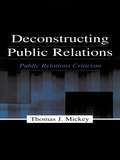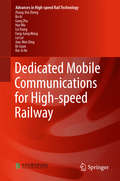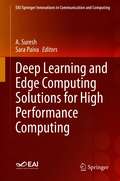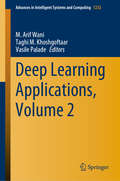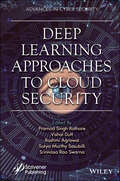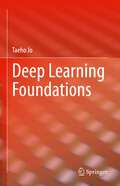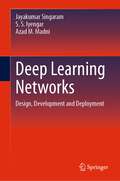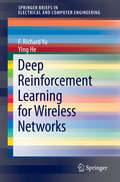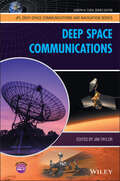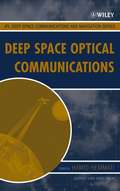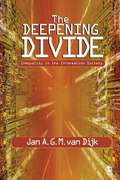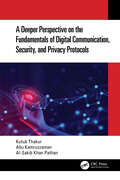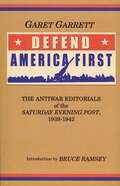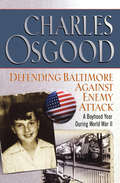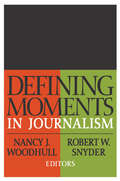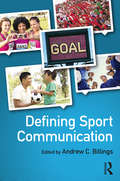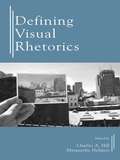- Table View
- List View
Deconstructing Public Relations: Public Relations Criticism (Routledge Communication Series)
by Thomas J. MickeyThis volume provides a critical look at public relations practice, utilizing case studies from public relations, advertising, and marketing to illustrate the deconstruction and analysis of public relations campaigns. Author Thomas J. Mickey uses a cultural studies approach and demonstrates how it can be used as a critical theory for public relations practice, offering real-world examples to support his argument. Through the interpretive act of deconstruction, this book serves to challenge the myth of public relations as an objective "science," allowing the social importance of public relations to be redefined and encouraging public relations to take a fuller place in the interdisciplinary study of text and knowledge. Intended for public relations scholars and students in public relations cases/campaigns, public relations criticism, and media studies courses, Deconstructing Public Relations: Public Relations Criticism demystifies the act of deconstruction and shows how it can give insight into the theory and practice of public relations.
Deconstructing Public Relations: Public Relations Criticism (Routledge Communication Series)
by Thomas J. MickeyThis volume provides a critical look at public relations practice, utilizing case studies from public relations, advertising, and marketing to illustrate the deconstruction and analysis of public relations campaigns. Author Thomas J. Mickey uses a cultural studies approach and demonstrates how it can be used as a critical theory for public relations practice, offering real-world examples to support his argument. Through the interpretive act of deconstruction, this book serves to challenge the myth of public relations as an objective "science," allowing the social importance of public relations to be redefined and encouraging public relations to take a fuller place in the interdisciplinary study of text and knowledge. Intended for public relations scholars and students in public relations cases/campaigns, public relations criticism, and media studies courses, Deconstructing Public Relations: Public Relations Criticism demystifies the act of deconstruction and shows how it can give insight into the theory and practice of public relations.
Dedicated Mobile Communications for High-speed Railway (Advances in High-speed Rail Technology)
by Zhang-Dui Zhong Bo Ai Gang Zhu Hao Wu Lei Xiong Fang-Gang Wang Lei Lei Jian-Wen Ding Ke Guan Rui-Si HeThis book addresses the fundamental theory and key technologies of narrowband and broadband mobile communication systems specifically for railways. It describes novel relaying schemes that meet the different design criteria for railways and discusses the applications of signal classification techniques as well as offline resource scheduling as a way of advancing rail practice. Further, it introduces Novel Long Term Evolution for Railway (LTE-R) network architecture, the Quality of Service (QoS) requirement of LTE-R and its performance evaluation and discusses in detail security technologies for rail-dedicated mobile communication systems. The advanced research findings presented in the book are all based on high-speed railway measurement data, which offer insights into the propagation mechanisms and corresponding modeling theory and approaches in unique railway scenarios.It is a valuable resource for researchers, engineers and graduate students in the fields of rail traffic systems, telecommunication and information systems.
Deep Learning and Edge Computing Solutions for High Performance Computing: High Performance Computing And Emerging Healthcare Technologies (EAI/Springer Innovations in Communication and Computing)
by A. Suresh Sara PaivaThis book provides an insight into ways of inculcating the need for applying mobile edge data analytics in bioinformatics and medicine. The book is a comprehensive reference that provides an overview of the current state of medical treatments and systems and offers emerging solutions for a more personalized approach to the healthcare field. Topics include deep learning methods for applications in object detection and identification, object tracking, human action recognition, and cross-modal and multimodal data analysis. High performance computing systems for applications in healthcare are also discussed. The contributors also include information on microarray data analysis, sequence analysis, genomics based analytics, disease network analysis, and techniques for big data Analytics and health information technology.
Deep Learning Applications, Volume 2 (Advances in Intelligent Systems and Computing #1232)
by M. Arif Wani Taghi M. Khoshgoftaar Vasile PaladeThis book presents selected papers from the 18th IEEE International Conference on Machine Learning and Applications (IEEE ICMLA 2019). It focuses on deep learning networks and their application in domains such as healthcare, security and threat detection, fault diagnosis and accident analysis, and robotic control in industrial environments, and highlights novel ways of using deep neural networks to solve real-world problems. Also offering insights into deep learning architectures and algorithms, it is an essential reference guide for academic researchers, professionals, software engineers in industry, and innovative product developers.
Deep Learning Approaches to Cloud Security
by Pramod Singh Rathore Vishal Dutt Rashmi Agrawal Satya Murthy Sasubilli Srinivasa Rao SwarnaDEEP LEARNING APPROACHES TO CLOUD SECURITY Covering one of the most important subjects to our society today, cloud security, this editorial team delves into solutions taken from evolving deep learning approaches, solutions allowing computers to learn from experience and understand the world in terms of a hierarchy of concepts, with each concept defined through its relation to simpler concepts. Deep learning is the fastest growing field in computer science. Deep learning algorithms and techniques are found to be useful in different areas like automatic machine translation, automatic handwriting generation, visual recognition, fraud detection, and detecting developmental delay in children. However, applying deep learning techniques or algorithms successfully in these areas needs a concerted effort, fostering integrative research between experts ranging from diverse disciplines from data science to visualization. This book provides state of the art approaches of deep learning in these areas, including areas of detection and prediction, as well as future framework development, building service systems and analytical aspects. In all these topics, deep learning approaches, such as artificial neural networks, fuzzy logic, genetic algorithms, and hybrid mechanisms are used. This book is intended for dealing with modeling and performance prediction of the efficient cloud security systems, thereby bringing a newer dimension to this rapidly evolving field. This groundbreaking new volume presents these topics and trends of deep learning, bridging the research gap, and presenting solutions to the challenges facing the engineer or scientist every day in this area. Whether for the veteran engineer or the student, this is a must-have for any library. Deep Learning Approaches to Cloud Security: Is the first volume of its kind to go in-depth on the newest trends and innovations in cloud security through the use of deep learning approaches Covers these important new innovations, such as AI, data mining, and other evolving computing technologies in relation to cloud security Is a useful reference for the veteran computer scientist or engineer working in this area or an engineer new to the area, or a student in this area Discusses not just the practical applications of these technologies, but also the broader concepts and theory behind how these deep learning tools are vital not just to cloud security, but society as a whole Audience: Computer scientists, scientists and engineers working with information technology, design, network security, and manufacturing, researchers in computers, electronics, and electrical and network security, integrated domain, and data analytics, and students in these areas
Deep Learning Approaches to Cloud Security
by Pramod Singh Rathore Vishal Dutt Rashmi Agrawal Satya Murthy Sasubilli Srinivasa Rao SwarnaDEEP LEARNING APPROACHES TO CLOUD SECURITY Covering one of the most important subjects to our society today, cloud security, this editorial team delves into solutions taken from evolving deep learning approaches, solutions allowing computers to learn from experience and understand the world in terms of a hierarchy of concepts, with each concept defined through its relation to simpler concepts. Deep learning is the fastest growing field in computer science. Deep learning algorithms and techniques are found to be useful in different areas like automatic machine translation, automatic handwriting generation, visual recognition, fraud detection, and detecting developmental delay in children. However, applying deep learning techniques or algorithms successfully in these areas needs a concerted effort, fostering integrative research between experts ranging from diverse disciplines from data science to visualization. This book provides state of the art approaches of deep learning in these areas, including areas of detection and prediction, as well as future framework development, building service systems and analytical aspects. In all these topics, deep learning approaches, such as artificial neural networks, fuzzy logic, genetic algorithms, and hybrid mechanisms are used. This book is intended for dealing with modeling and performance prediction of the efficient cloud security systems, thereby bringing a newer dimension to this rapidly evolving field. This groundbreaking new volume presents these topics and trends of deep learning, bridging the research gap, and presenting solutions to the challenges facing the engineer or scientist every day in this area. Whether for the veteran engineer or the student, this is a must-have for any library. Deep Learning Approaches to Cloud Security: Is the first volume of its kind to go in-depth on the newest trends and innovations in cloud security through the use of deep learning approaches Covers these important new innovations, such as AI, data mining, and other evolving computing technologies in relation to cloud security Is a useful reference for the veteran computer scientist or engineer working in this area or an engineer new to the area, or a student in this area Discusses not just the practical applications of these technologies, but also the broader concepts and theory behind how these deep learning tools are vital not just to cloud security, but society as a whole Audience: Computer scientists, scientists and engineers working with information technology, design, network security, and manufacturing, researchers in computers, electronics, and electrical and network security, integrated domain, and data analytics, and students in these areas
Deep Learning Foundations
by Taeho JoThis book provides a conceptual understanding of deep learning algorithms. The book consists of the four parts: foundations, deep machine learning, deep neural networks, and textual deep learning. The first part provides traditional supervised learning, traditional unsupervised learning, and ensemble learning, as the preparation for studying deep learning algorithms. The second part deals with modification of existing machine learning algorithms into deep learning algorithms. The book’s third part deals with deep neural networks, such as Multiple Perceptron, Recurrent Networks, Restricted Boltzmann Machine, and Convolutionary Neural Networks. The last part provides deep learning techniques that are specialized for text mining tasks. The book is relevant for researchers, academics, students, and professionals in machine learning.
Deep Learning Networks: Design, Development and Deployment
by Jayakumar Singaram S. S. Iyengar Azad M. MadniThis textbook presents multiple facets of design, development and deployment of deep learning networks for both students and industry practitioners. It introduces a deep learning tool set with deep learning concepts interwoven to enhance understanding. It also presents the design and technical aspects of programming along with a practical way to understand the relationships between programming and technology for a variety of applications. It offers a tutorial for the reader to learn wide-ranging conceptual modeling and programming tools that animate deep learning applications. The book is especially directed to students taking senior level undergraduate courses and to industry practitioners interested in learning about and applying deep learning methods to practical real-world problems.
Deep Reinforcement Learning for Wireless Networks (SpringerBriefs in Electrical and Computer Engineering)
by F. Richard Yu Ying HeThis Springerbrief presents a deep reinforcement learning approach to wireless systems to improve system performance. Particularly, deep reinforcement learning approach is used in cache-enabled opportunistic interference alignment wireless networks and mobile social networks. Simulation results with different network parameters are presented to show the effectiveness of the proposed scheme. There is a phenomenal burst of research activities in artificial intelligence, deep reinforcement learning and wireless systems. Deep reinforcement learning has been successfully used to solve many practical problems. For example, Google DeepMind adopts this method on several artificial intelligent projects with big data (e.g., AlphaGo), and gets quite good results.. Graduate students in electrical and computer engineering, as well as computer science will find this brief useful as a study guide. Researchers, engineers, computer scientists, programmers, and policy makers will also find this brief to be a useful tool.
Deep Space Communications (JPL Deep-Space Communications and Navigation Series)
by Jim TaylorA collection of some of the Jet Propulsion Laboratory's space missions selected to represent the planetary communications designs for a progression of various types of missions The text uses a case study approach to show the communications link performance resulting from the planetary communications design developed by the Jet Propulsion Laboratory (JPL). This is accomplished through the description of the design and performance of six representative planetary missions. These six cases illustrate progression through time of the communications system's capabilities and performance from 1970s technology to the most recent missions. The six missions discussed in this book span the Voyager for fly-bys in the 1970s, Galileo for orbiters in the 1980s, Deep Space 1 for the 1990s, Mars Reconnaissance Orbiter (MRO) for planetary orbiters, Mars Exploration Rover (MER) for planetary rovers in the 2000s, and the MSL rover in the 2010s. Deep Space Communications: Provides an overview of the Deep Space Network and its capabilities Examines case studies to illustrate the progression of system design and performance from mission to mission and provides a broad overview of the missions systems described Discusses actual flight mission telecom performance of each system Deep Space Communications serves as a reference for scientists and engineers interested in communications systems for deep-space telecommunications link analysis and design control.
Deep Space Communications (JPL Deep-Space Communications and Navigation Series)
by Jim TaylorA collection of some of the Jet Propulsion Laboratory's space missions selected to represent the planetary communications designs for a progression of various types of missions The text uses a case study approach to show the communications link performance resulting from the planetary communications design developed by the Jet Propulsion Laboratory (JPL). This is accomplished through the description of the design and performance of six representative planetary missions. These six cases illustrate progression through time of the communications system's capabilities and performance from 1970s technology to the most recent missions. The six missions discussed in this book span the Voyager for fly-bys in the 1970s, Galileo for orbiters in the 1980s, Deep Space 1 for the 1990s, Mars Reconnaissance Orbiter (MRO) for planetary orbiters, Mars Exploration Rover (MER) for planetary rovers in the 2000s, and the MSL rover in the 2010s. Deep Space Communications: Provides an overview of the Deep Space Network and its capabilities Examines case studies to illustrate the progression of system design and performance from mission to mission and provides a broad overview of the missions systems described Discusses actual flight mission telecom performance of each system Deep Space Communications serves as a reference for scientists and engineers interested in communications systems for deep-space telecommunications link analysis and design control.
Deep Space Optical Communications (JPL Deep-Space Communications and Navigation Series #11)
by Hamid HemmatiA quarter century of research into deep space and near Earth optical communications This book captures a quarter century of research and development in deep space optical communications from the Jet Propulsion Laboratory (JPL). Additionally, it presents findings from other optical communications research groups from around the world for a full perspective. Readers are brought up to date with the latest developments in optical communications technology, as well as the state of the art in component and subsystem technologies, fundamental limitations, and approaches to develop and fully exploit new technologies. The book explores the unique requirements and technologies for deep space optical communications, including: * Technology overview; link and system design drivers * Atmospheric transmission, propagation, and reception issues * Flight and ground terminal architecture and subsystems * Future prospects and applications, including navigational tracking and light science This is the first book to specifically address deep space optical communications. With an increasing demand for data from planetary spacecraft and other sources, it is essential reading for all optical communications, telecommunications, and system engineers, as well as technical managers in the aerospace industry. It is also recommended for graduate students interested in deep space communications.
The Deepening Divide: Inequality in the Information Society (PDF)
by Dijk, Jan A. G. M. vanDuring the mid 90's, around the time the Internet became popular, it became apparent that there was still one critical issue holding back limitless opportunities. Computer professionals had to find a way to close the gap between those who do not have computer or Internet access and those who do, also known as the digital divide. Suddenly, hundreds of conferences of computer professionals, social scientists, and government policy experts worldwide dedicated themselves to this concern. Then the Internet hype seemed to dissipate, and observers assumed the digital divide would fix itself. The Deepening Divide explains why the digital divide is still widening and, in advanced high-tech societies, deepening. Taken from an international perspective, the book offers full coverage of the literature and research and a theoretical framework from which to analyze and approach the issue. Where most books on the digital divide only describe and analyze the issue, Jan van Dijk presents 26 policy perspectives and instruments designed to close the divide itself.
A Deeper Perspective on the Fundamentals of Digital Communication, Security, and Privacy Protocols
by Kutub Thakur Abu Kamruzzaman Al-Sakib Khan PathanThis book, divided into three parts, describes the detailed concepts of Digital Communication, Security, and Privacy protocols. In Part One, the first chapter provides a deeper perspective on communications, while Chapters 2 and 3 focus on analog and digital communication networks. Part Two then delves into various Digital Communication protocols. Beginning first in Chapter 4 with the major Telephony protocols, Chapter 5 then focuses on important Data Communication protocols, leading onto the discussion of Wireless and Cellular Communication protocols in Chapter 6 and Fiber Optic Data Transmission protocols in Chapter 7. Part Three covers Digital Security and Privacy protocols including Network Security protocols (Chapter 8), Wireless Security protocols (Chapter 9), and Server Level Security systems (Chapter 10), while the final chapter covers various aspects of privacy related to communication protocols and associated issues. This book will offer great benefits to graduate and undergraduate students, researchers, and practitioners. It could be used as a textbook as well as reference material for these topics. All the authors are well-qualified in this domain. The authors have an approved textbook that is used in some US, Saudi, and Bangladeshi universities since Fall 2020 semester – although used in online lectures/classes due to COVID-19 pandemic.
A Deeper Perspective on the Fundamentals of Digital Communication, Security, and Privacy Protocols
by Kutub Thakur Abu Kamruzzaman Al-Sakib Khan PathanThis book, divided into three parts, describes the detailed concepts of Digital Communication, Security, and Privacy protocols. In Part One, the first chapter provides a deeper perspective on communications, while Chapters 2 and 3 focus on analog and digital communication networks. Part Two then delves into various Digital Communication protocols. Beginning first in Chapter 4 with the major Telephony protocols, Chapter 5 then focuses on important Data Communication protocols, leading onto the discussion of Wireless and Cellular Communication protocols in Chapter 6 and Fiber Optic Data Transmission protocols in Chapter 7. Part Three covers Digital Security and Privacy protocols including Network Security protocols (Chapter 8), Wireless Security protocols (Chapter 9), and Server Level Security systems (Chapter 10), while the final chapter covers various aspects of privacy related to communication protocols and associated issues. This book will offer great benefits to graduate and undergraduate students, researchers, and practitioners. It could be used as a textbook as well as reference material for these topics. All the authors are well-qualified in this domain. The authors have an approved textbook that is used in some US, Saudi, and Bangladeshi universities since Fall 2020 semester – although used in online lectures/classes due to COVID-19 pandemic.
Defend America First: The Antiwar Editorials Of The Saturday Evening Post, 1939-1942
by Garet Garrett Bruce RamseyDefending Baltimore Against Enemy Attack: A Boyhood Year During World War II
by Charles OsgoodFrom beloved broadcaster Charles Osgood, a poignant memoir about one unforgettable childhood year during World War II. Defending Baltimore Against Enemy Attack is a gloriously funny and nostalgic slice of American life and a moving look at World War II from the perspective of a child far away from the fighting, but very conscious of the reverberations. With a sharp eye for details, Osgood captures the texture of life in a bygone era.
Defending Baltimore Against Enemy Attack: A Boyhood Year During World War II
by Charles OsgoodFrom beloved broadcaster Charles Osgood, a poignant memoir about one unforgettable childhood year during World War II.Defending Baltimore Against Enemy Attack is a gloriously funny and nostalgic slice of American life and a moving look at World War II from the perspective of a child far away from the fighting, but very conscious of the reverberations. With a sharp eye for details, Osgood captures the texture of life in a bygone era.
Defining Moments in Journalism
by Nancy J. Woodhull Robert W. SnyderMost great transformations are not apparent as we live through them. Only in hindsight do individual moments acquire layers of meaning that give them great significance. Looking back is not something that comes naturally to journalists, immersed as they are in breaking events and relentless deadlines. But there is still good reason for journalists, scholars, and people who care about journalism to think about the critical episodes in its recent evolution. In Defining Moments in Journalism, such authors vividly describe episodes of this kind. Some of the chapters and contributors include: "The Lessons of Little Rock" by Harry S. Ashmore; "Vietnam and War Reporting" by Peter Arnett; "Photo-journalists--Visionaries Who Have Changed Our Vision" by Jane M. Rosett; "The Weight of Watergate" by Ellen Hume; "Women Sportswriters--Business as Usual" by Mary Schmitt; "The Connie Chung Phenomenon" by Somini Sengupta; and "Covering Politics--Is There a Female Difference?" by Judy Woodruff. The years since the Great Depression and World War II have seen vast changes in America and also in its journalism. Journalists' relationship to power and authority is more complex; the press corps has become more diverse; the technology of news reporting is almost unrecognizably different from that of fifty years ago; and economic reorganization of the media has bundled news and entertainment organizations into conglomerates of extraordinary size. 'Defining Moments in Journalism' is a fascinating read for communications scholars and professionals, historians, and political scientists.
Defining Moments in Journalism
by Nancy J. Woodhull Robert W. SnyderMost great transformations are not apparent as we live through them. Only in hindsight do individual moments acquire layers of meaning that give them great significance. Looking back is not something that comes naturally to journalists, immersed as they are in breaking events and relentless deadlines. But there is still good reason for journalists, scholars, and people who care about journalism to think about the critical episodes in its recent evolution. In Defining Moments in Journalism, such authors vividly describe episodes of this kind. Some of the chapters and contributors include: "The Lessons of Little Rock" by Harry S. Ashmore; "Vietnam and War Reporting" by Peter Arnett; "Photo-journalists--Visionaries Who Have Changed Our Vision" by Jane M. Rosett; "The Weight of Watergate" by Ellen Hume; "Women Sportswriters--Business as Usual" by Mary Schmitt; "The Connie Chung Phenomenon" by Somini Sengupta; and "Covering Politics--Is There a Female Difference?" by Judy Woodruff. The years since the Great Depression and World War II have seen vast changes in America and also in its journalism. Journalists' relationship to power and authority is more complex; the press corps has become more diverse; the technology of news reporting is almost unrecognizably different from that of fifty years ago; and economic reorganization of the media has bundled news and entertainment organizations into conglomerates of extraordinary size. 'Defining Moments in Journalism' is a fascinating read for communications scholars and professionals, historians, and political scientists.
Defining Sport Communication
by Andrew C. BillingsDefining Sport Communication is a comprehensive resource addressing core topics and issues, including humanistic, organizational, relational, and mediated approaches to the study of sport communication. It provides foundational work in sport communication for students and scholars, reflecting the abundance of research published in recent years and the ever-increasing interest in this area of study. Bringing together scholars from various epistemological viewpoints within communication, this volume provides a unique opportunity for defining the breadth and depth of sport communication research. It will serve as a seminal reference for existing scholarship while also providing an agenda for future research.
Defining Sport Communication
by Andrew C. BillingsDefining Sport Communication is a comprehensive resource addressing core topics and issues, including humanistic, organizational, relational, and mediated approaches to the study of sport communication. It provides foundational work in sport communication for students and scholars, reflecting the abundance of research published in recent years and the ever-increasing interest in this area of study. Bringing together scholars from various epistemological viewpoints within communication, this volume provides a unique opportunity for defining the breadth and depth of sport communication research. It will serve as a seminal reference for existing scholarship while also providing an agenda for future research.
Defining Visual Rhetorics
by Charles A. Hill Marguerite HelmersImages play an important role in developing consciousness and the relationship of the self to its surroundings. In this distinctive collection, editors Charles A. Hill and Marguerite Helmers examine the connection between visual images and persuasion, or how images act rhetorically upon viewers. Chapters included here highlight the differences and commonalities among a variety of projects identified as "visual rhetoric," leading to a more precise definition of the term and its role in rhetorical studies. Contributions to this volume consider a wide variety of sites of image production--from architecture to paintings, from film to needlepoint--in order to understand how images and texts work upon readers as symbolic forms of representation. Each chapter discusses, analyzes, and explains the visual aspect of a particular subject, and illustrates the ways in which messages and meaning are communicated visually. The contributions include work from rhetoric scholars in the English and communication disciplines, and represent a variety of methodologies--theoretical, textual analysis, psychological research, and cultural studies, among others. The editors seek to demonstrate that every new turn in the study of rhetorical practices reveals more possibilities for discussion, and that the recent "turn to the visual" has revealed an inexhaustible supply of new questions, problems, and objects for investigation. As a whole, the chapters presented here demonstrate the wide range of scholarship that is possible when a field begins to take seriously the analysis of images as important cultural and rhetorical forces. Defining Visual Rhetorics is appropriate for graduate or advanced undergraduate courses in rhetoric, English, mass communication, cultural studies, technical communication, and visual studies. It will also serve as an insightful resource for researchers, scholars, and educators interested in rhetoric, cultural studies, and communication studies.
Defining Visual Rhetorics
by Charles A. Hill Marguerite HelmersImages play an important role in developing consciousness and the relationship of the self to its surroundings. In this distinctive collection, editors Charles A. Hill and Marguerite Helmers examine the connection between visual images and persuasion, or how images act rhetorically upon viewers. Chapters included here highlight the differences and commonalities among a variety of projects identified as "visual rhetoric," leading to a more precise definition of the term and its role in rhetorical studies. Contributions to this volume consider a wide variety of sites of image production--from architecture to paintings, from film to needlepoint--in order to understand how images and texts work upon readers as symbolic forms of representation. Each chapter discusses, analyzes, and explains the visual aspect of a particular subject, and illustrates the ways in which messages and meaning are communicated visually. The contributions include work from rhetoric scholars in the English and communication disciplines, and represent a variety of methodologies--theoretical, textual analysis, psychological research, and cultural studies, among others. The editors seek to demonstrate that every new turn in the study of rhetorical practices reveals more possibilities for discussion, and that the recent "turn to the visual" has revealed an inexhaustible supply of new questions, problems, and objects for investigation. As a whole, the chapters presented here demonstrate the wide range of scholarship that is possible when a field begins to take seriously the analysis of images as important cultural and rhetorical forces. Defining Visual Rhetorics is appropriate for graduate or advanced undergraduate courses in rhetoric, English, mass communication, cultural studies, technical communication, and visual studies. It will also serve as an insightful resource for researchers, scholars, and educators interested in rhetoric, cultural studies, and communication studies.
